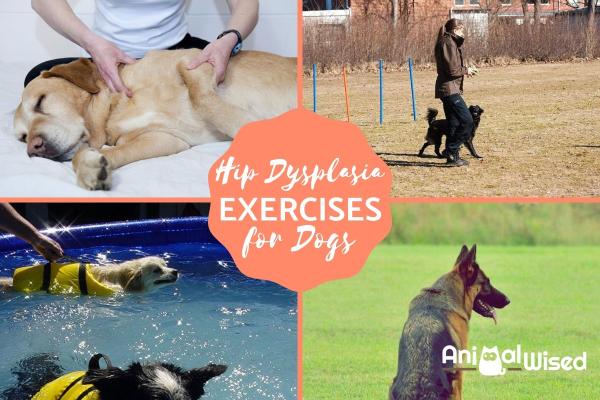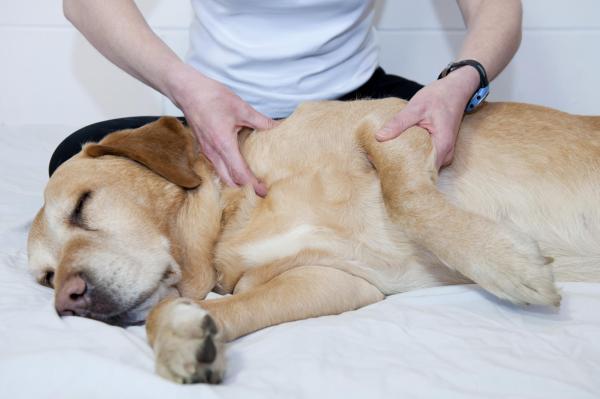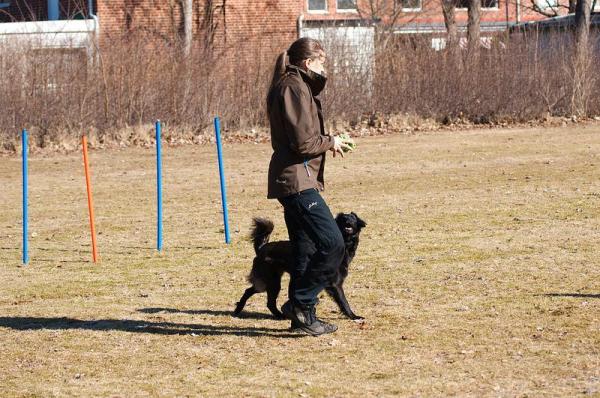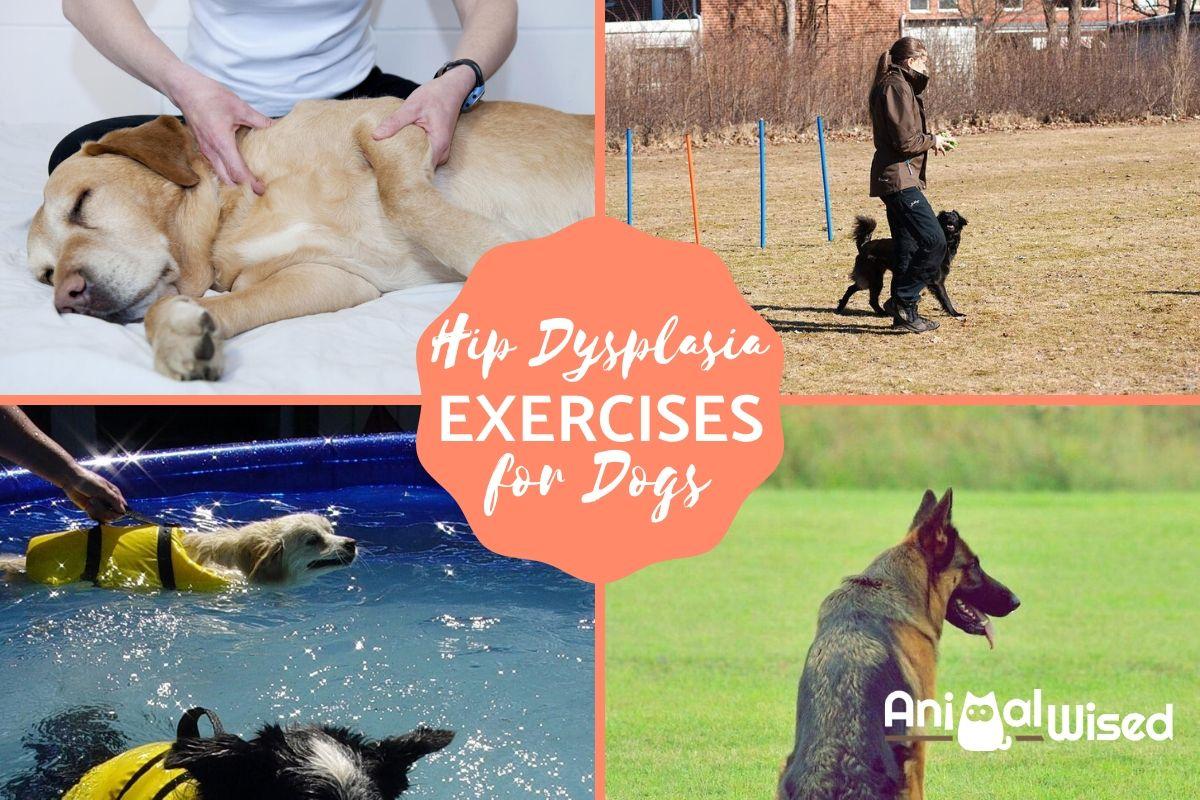Exercises to Help Dogs With Hip Dysplasia



See files for Dogs
Hip dysplasia is a well-known health problem which affects many dogs worldwide. Thanks to hereditary genetic factors, certain breeds are more prone to this degenerative disorder than others, but almost any dog can develop the condition. For this reason, all dog guardians need to be observant for possible signs of mobility issues in their companion animals. If you have noticed these symptoms and your veterinarian has diagnosed them with hip dysplasia, they will provide guidance on how to treat them.
AnimalWised brings you this guide on different exercises to help dogs with hip dysplasia. We show you what works best to help slow degeneration and manage the often painful symptoms of the condition.
What is hip dysplasia?
Hip dysplasia is a condition which results from the abnormal conformation of the hip joint. The joint cavity (acetabulum) and the ball of the femur bone do not lock in with each other properly. There are two general types of hip dysplasia in dogs:
- Congenital: this is when the condition is inherited genetically. It is believed to be due to the two main parts of the hip joint not growing at the same rate, likely due to hormonal issues.
- Acquired: when something in the environment leads to a dog's joints becoming damaged or worn to the point whey they do not connect. While overall neutering is still advisable for the overall healthy of a dog, it is believed that neutering a dog too early may lead to an increased prevalence of hip dysplasia[1]. Excess protein in the diet or putting too much strain on the dog's joints when they are still developing may also be factors.
Diagnosis of hip dysplasia will require x-rays and, potentially, other clinical tests. However, we need to keep an eye out for possible symptoms. These include difficult standing up, becoming excessively tired after walks or a change in their gait.
Due to its genetic inheritance prevalence, there are some breeds which are more likely to develop hip dysplasia than others. They include:
- Labrador Retriever
- Irish Setter
- German Shepherd
- Dobermann
- Dalmatian
- Boxer
Although we have exposed some breeds that have a predisposition, that does not mean other breeds cannot develop the condition. If they do, there is no cure. The most drastic approach is surgical intervention, but even this may only yield limited results. Most important is to reduce associated pain and other issues with proper symptom management.
How to help a dog with hip dysplasia
There are several physiotherapy techniques you can apply to help your dog with hip dysplasia. All of them should have the aim of strengthening and relaxing muscles to ease discomfort or relieve pain. The gluteal muscles are essential for the stability and mobility of the hip, so performing therapy on them is important.
Other methods of helping the dog with hip dysplasia include changing their diet to help maintain joint function. While this includes giving them omega-3 fatty acid-rich food, it also means limiting their total amount so they don't become obese. Being overweight exerts greater pressure on the already damaged joints.
This is why exercises to help dogs with hip dysplasia need to help the joints recover without damaging them further. We bring you some of the best for your dog.

1. Massage
A dog with hip dysplasia will struggle to support themselves on any affected limbs. This is because the pain makes it difficult to put pressure on it. The result will be muscular atrophy, i.e. the loss of muscle mass due to inactivity or other affects on the musculoskeletal system of the dog. Massaging the dog favors recovery of muscle mass as well as helping to correct their posture.
We can perform a relaxing massage along the dog's spine. It is important we move our hands along the grain of the dog's hair as it can be very uncomfortable if we don't. We should also make circular movements along both sides of the spine to release tension. The muscles of the hindquarters, however, are perhaps the most important to focus on.
There are some massage aids we can use to help provide a relaxing and effective massage. However, we need to always register the dog's reaction and ensure we don't make them uncomfortable. Start gentle and work your way up. If you want to know more, you can also take a look at our article on where to pet a dog to relax them.
Passive movements
If your dog has undergone surgery for hip dysplasia, you will need to wait at least one week before you can start physiotherapy. However, ensure you speak to your veterinarian for a specific start date. After this time, you will be able to carefully manipulate the affected joint. Ensure you keep the dog on a soft bed to ensure comfort.
Passive movements are ideal ways to help manage joint dysfunction caused by hip dysplasia. However, they are not suitable for healthy dogs as they can cause damage. The guardian must perform all movements on the dog while they are lying on their side, remaining relaxed and still. Before starting passive movements, we should warm them up with a massage or warming the affected area.
Here we explain the manipulations you need to make to the right hip. If your dog is affected on their left hip, then you need to switch the movements accordingly. If the dog's right hip is affected, we lay them down on the left side touching the ground. Lift their rear leg perpendicular to the body, but in a level plane, i.e. don't stretch it to an uncomfortable position (see photo below).
- Flexion/extension: with our right hand, we are going to hold their left rear leg to the level of their knee and rest the leg on our right arm. Then our right hand is used to create the normal movements of a dog walking, moving the hip in an almost circular motion and extend and contracting the leg as you do. During this, your left hand should hold the joint and check for any signs of pain or friction. Do this about 10 to 15 times.
- Abduction/adduction: abduction is the action of moving the leg away from the body, while adduction is bringing it closer. We stand behind the dog, take their bent knee and smoothly carry out the movements 10-15 times.
It is important that we make sure that the bottom leg is resting on the ground. We need to stop immediately if they try to pull away. For both movements, we have to ensure that only one hip joint is moving at a time. As with massage, we need to gauge the sensitivity of the dog and increase movements incrementally. These physical therapy exercises are used to lessen pain, not increase it.

3. Active or stabilizing exercises
Stabilizing exercises are good both for a dog with hip dysplasia which cannot take long walks. It is also used as a conservative intervention to best avoid a surgical operation. However, they may also be good for dogs which have undergone surgery and need rehabilitation for their hip.
These exercises can generally be performed about 3 weeks after the operation. Again, we need to have permission from the veterinarian before we can start. Also, the size of the dog may be an important factor. If we are using these active techniques on our dog combined with massage and passive movements, it is important to leave these until the end.
Support technique
We place the dog with their front legs raised on a support. For a small dog, this could be a thick book, larger dogs may need a stool. The pose is designed to create tension in the muscles of the spine and hind limbs. Support exercises tire the dog out, especially after surgery. For this reason, 5 repetitions of the three stages should be sufficient at first. The stages are:
- We stand behind the dog and hold them for balance. Take the dog's leg and gently pull it towards the tail. This should stretch out all of the dog's muscles in their limbs, abdomen and back. Hold for a few seconds, relax and repeat about 5 times.
- Then we need to take the knee joint and also pull it towards the tail. We should feel in our hands the relaxation of the hip muscles and posterior. Again, hold for a few seconds, relax and repeat 5 times.
- Hold the knee joint up high and this time press it forward towards the dog's head. Hold for a few seconds, relax and repeat 5 times. Over time the dog will become used to support exercises and their muscles will strengthen.

Trampoline
The trampoline is an unknown object for the dog. For this reason, we need to gradually introduce them to it and let them become accustomed. You may not be able to perform the exercises on the first attempt since they are not yet used to the apparatus.
It is essential the trampoline can easily support the weigh of both the dog and ourselves. A good way to introduce the dog to the trampoline is for us to get on first and have someone else bring the dog up to us. We can then reassure them with petting and treats when they have calmed down.
- First we need to hold the dog around the abdomen for stability and gently rock them up and down on the trampoline. Do not bounce them and be careful not to disturb the trampoline.
- It is important to perform these movements slowly and carefully. Thus we can feel how the dog actions their muscles to maintain balance. This exercise is not visually impressive but in reality it exerts an intense action on the musculature. At the same time it develops the gluteal musculature of the dog, it tires them out, so do not do too many repetitions.
- The guardian needs to get on and off first to avoid injury.
Slalom
When enough time has passed after a dysplasia operation, and according to the vet's permission, walking through a slalom can be helpful. The space between the cones needs to be 50 cm to 1 m, depending on the size of the dog. You can see an example of a slalom set up for a dog above. Never force them to run, even if they are getting excited.
Dogs will often push themselves through pain, especially if they are keen to appease their guardian. Dog agility exercises are normally for agile dogs, something hip dysplasia affects greatly.
Hydrotherapy
With dogs which are comfortable in water, swimming can be a great way to strengthen their muscles without overloading their joints. This is because being suspended in water means they don't have to place any wait on the injured joint.
Specialists will have hydrotherapy facilities which are greater than we are likely to have at home. These may include having an underwater treadmill or other pool facilities. These exercises for hip dysplasia need to be carried out by a professional physiotherapist.
However, if you have a pool at home, it is possible you can support them on floats and let them kick their legs. You can even get special floating harnesses like the ones in the picture below to help hold them in the water. They are also used to help dogs with stiff joints.
If the dog is at all uncomfortable in water, then this is not a good idea. Jerking out of fear or some other quick movement can lead to further damage.

Other physiotherapy
For more advanced techniques, a physical therapist can be consulted. In addition to the previous physiotherapy exercises for dogs with hip dysplasia, they may be able to carry out:
- Cryotherapy
- Thermotherapy
- Electrotherapy
However, it is important to note that many of these therapies are considered ‘alternative’ and have little scientific evidence to support their efficacy. For example, some people recommend acupuncture for the dog, but this is a practice which has very little evidence to support it works. What little support it has tends to be placebo, something which won't work on a dog since they don't understand the concept. Moreover, they may find the process of having needles put into their skin to be scary.
If you want to look into other methods of treating your dog's hip dysplasia, you will need to discuss them with your veterinarian beforehand.

This article is purely informative. AnimalWised does not have the authority to prescribe any veterinary treatment or create a diagnosis. We invite you to take your pet to the veterinarian if they are suffering from any condition or pain.
If you want to read similar articles to Exercises to Help Dogs With Hip Dysplasia, we recommend you visit our Degenerative diseases category.
1. Torres de la Riva, G., et al. (2013). Neutering Dogs: Effects on Joint Disorders and Cancers in Golden Retrievers. PLoS One, 8(2), e55937.
https://journals.plos.org/plosone/article?id=10.1371/journal.pone.0055937









